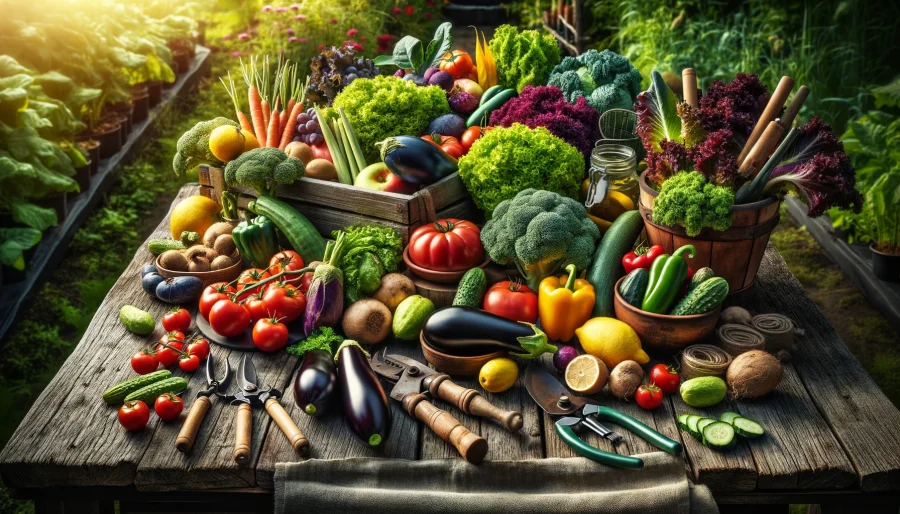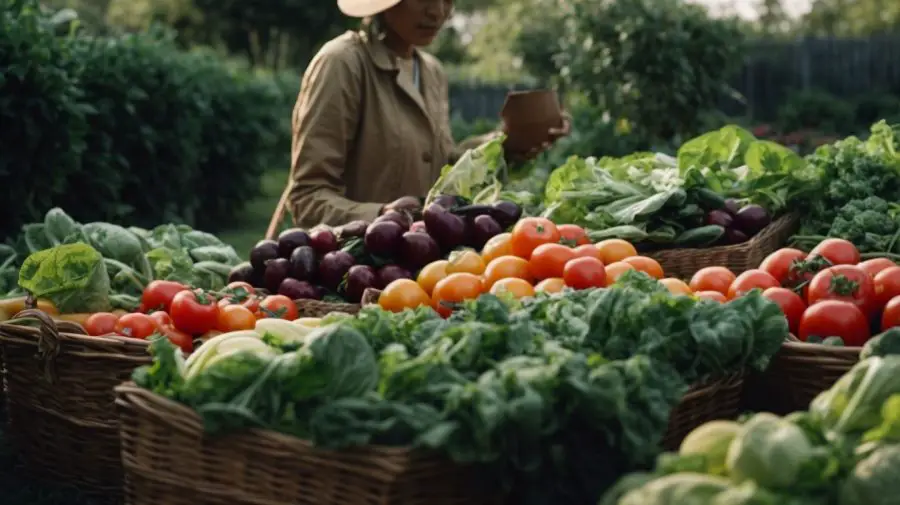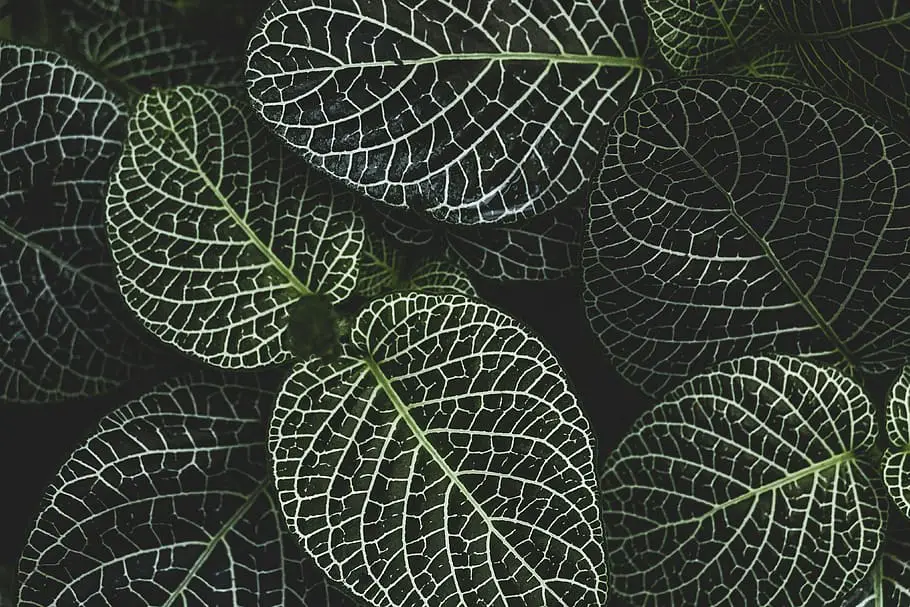We use affiliate links. If you purchase something using one of these links, we may receive compensation or commission.

Discover the art of harvesting and enjoying your produce with essential tips on timing, techniques, and creative ways to savor your garden’s bounty.
Harvesting and Enjoying Your Produce Key Takeaways:
- Harvesting and enjoying your produce involves picking fruits and vegetables at their peak ripeness
- Use proper techniques to ensure freshness
- Creatively using your harvest in meals.
- It’s about savoring the flavors of your garden and making the most of your hard work.
Harvesting and Enjoying Your Produce
Welcome to the world of harvesting and enjoying your produce!
Are you eager to learn more about produce harvesting and how to make the most of your bountiful harvest?
In this article, we will explore the ins and outs of harvesting produce, including the best time to harvest, signs that your produce is ready, and the proper techniques for harvesting.
We will also discuss common mistakes to avoid and ways to enjoy your freshly harvested fruits and vegetables.
So grab your gardening tools and get ready to dive into the world of produce harvesting!
What Is Produce Harvesting?
Produce harvesting involves the process of gathering ripe fruits, vegetables, and herbs from gardens or farms to store or use.
Harvesting fresh and ripe produce is crucial to ensure optimal flavor, nutrition, and quality. By picking the produce at the right time, it retains maximum nutrients and tastes delicious.
Commonly harvested fruits include apples, oranges, and berries, while vegetables like tomatoes, cucumbers, and lettuce are also popular choices.
Herbs such as basil, mint, and cilantro add freshness to dishes.
Proper storage post-harvest is essential to maintain freshness and prevent spoilage.
Utilizing harvested produce promptly in recipes promotes a healthy diet and reduces wastage.
Harvesting and storing home garden vegetables
When Is the Best Time to Harvest Produce?
 Determining the best time to harvest produce depends on factors such as ripeness, freshness, maturity, and environmental conditions like temperature and humidity.
Determining the best time to harvest produce depends on factors such as ripeness, freshness, maturity, and environmental conditions like temperature and humidity.
A crucial aspect of determining the ideal time to harvest produce is assessing the signs of ripeness, which vary depending on the type of fruit or vegetable.
For instance, ripe tomatoes often have a vibrant color and yield slightly to gentle pressure, while ripe melons emit a sweet aroma.
These visual and tactile cues guide farmers in gauging the maturity level of the crop.
Freshness indicators such as firmness and lack of blemishes play a significant role in deciding when to harvest to ensure top-quality produce.
What Are the Signs That Produce Is Ready to Be Harvested?
Visual cues such as color changes, firmness, aroma, and taste can signify that the produce is ready to be harvested, ensuring optimal flavor and nutritional quality.
For vegetables like tomatoes, ripe fruits will exhibit a vibrant, rich color, usually deepening from green to red, orange, or yellow, depending on the variety.
When gently squeezed, the vegetable should yield slightly without being too soft, indicating ripeness.
A sweet, earthy aroma near the stem is also a good indicator of readiness.
Herbs, on the other hand, are best harvested just before flowering when their flavors are most potent.
A gentle pinch at the stem should release a burst of fragrance, signaling peak flavor.
Fruits like melons often emit a sweet, musky scent when ripe, and a slight softness at the blossom end of the fruit indicates it’s ready to be enjoyed.
For leafy greens, younger leaves generally offer a more tender texture and milder flavor, ideal for harvesting before the plant bolts or becomes excessively bitter.
How Do You Properly Harvest Produce?
Properly harvesting produce involves selecting appropriate methods for different types of vegetables, fruits, and herbs, ensuring careful handling and timely storage.
In terms of vegetables, it’s crucial to consider the specific harvesting techniques each kind requires.
For instance, leafy greens like lettuce are best picked in the morning when they’re crisp and full of moisture, while root vegetables such as carrots need to be gently loosened from the soil to prevent damage during harvest.
Similarly, fruits like berries should be harvested when fully ripe but still firm, a delicate balance that ensures optimal flavor.
Herbs, on the other hand, should be cut just above a pair of leaves to promote new growth and maintain flavor intensity.
Choosing the Right Tools
Selecting the right tools for harvesting vegetables, fruits, and herbs is essential to ensure efficient and damage-free picking.
In terms of harvesting your garden bounty, having the appropriate tools can make all the difference.
For vegetables, tools like handheld pruners and shears are ideal for delicate items like herbs and leafy greens, ensuring a clean cut without damaging the plant.
For fruits, consider using gentle tools such as a fruit picker or harvesting pouch to prevent bruising and ensure a bountiful harvest.
Each tool serves a specific function, from gently cradling ripe fruits to precision cutting, allowing you to harvest with care and precision.
Properly Handling the Produce
Proper handling of harvested produce is crucial to maintain freshness, prevent damage, and ensure optimal storage conditions.
One important technique to minimize damage to freshly harvested produce is proper sorting and grading, which involves separating produce based on ripeness, size, and quality.
Implementing careful washing and cleaning methods is also crucial to remove dirt and contaminants without compromising the produce’s integrity.
Utilizing appropriate packaging materials such as breathable bags or containers can help maintain the produce’s freshness by allowing proper airflow.
Rapid cooling methods like refrigeration or hydro cooling can prolong the shelf-life of fruits and vegetables.
Removing the Produce from the Plant
Carefully removing produce from plants post-harvest is vital to prevent injuries to the plant and ensure the continued growth of the remaining produce.
When harvesting, gently cradle the produce in your hand, avoiding squeezing or crushing to maintain its freshness and quality.
Ensure you use sharp and clean tools to make precise cuts on the plant, minimizing damage.
Plants should be regularly checked for any signs of disease or pest infestations, as these can affect the quality of the produce.
Post-harvest, it is important to store the harvested produce in the correct conditions, considering factors like temperature, humidity, and air circulation to prolong its shelf life.
Storing the Produce
Storing harvested produce correctly involves maintaining optimal conditions of temperature, humidity, and airflow to prolong shelf-life and preserve freshness.
Proper storage techniques are crucial for ensuring the quality and safety of fresh produce.
Temperature control is key, as different fruits and vegetables have varying ideal temperature ranges.
For example, apples and oranges are best stored at around 30-35°F, while leafy greens prefer slightly higher temperatures around 40°F.
Monitoring the humidity levels is also vital, as excessive moisture can lead to mold growth, whereas too-dry conditions can cause wilting.
The importance of airflow in storage spaces cannot be overlooked.
Good airflow helps in regulating temperature and humidity levels evenly throughout the storage area, reducing the risk of hot spots or condensation.
What Are Some Common Mistakes When Harvesting Produce?
Common mistakes when harvesting produce include picking too early, inadequate cleaning, and improper storage practices, which can impact the quality and shelf-life of the produce.
Harvesting produce is a crucial task in ensuring fresh and high-quality fruits and vegetables for consumers.
Picking fruits or vegetables prematurely can result in a lack of sweetness or flavor development, affecting the overall taste.
Inadequate cleaning procedures post-harvest can lead to bacterial contamination and spoilage, reducing the market value of the produce.
Improper storage methods, such as exposing harvested crops to direct sunlight or storing them in damp conditions, can accelerate deterioration and shorten the shelf-life significantly.
To avoid these issues, it is essential to harvest at the right maturity stage, implement proper cleaning protocols, and store the produce in suitable environments to maintain freshness and quality.
Harvesting Too Early
Harvesting produce prematurely can result in underdeveloped flavors, reduced nutritional value, and shorter shelf-life, affecting the overall quality of the harvested items.
When fruits or vegetables are picked too early, they have not had the chance to fully develop their natural sugars and flavors, resulting in a lackluster taste experience.
Optimal harvest time plays a crucial role in determining the peak of ripeness when the produce is at its best in terms of flavor, texture, and nutritional content.
By picking at the right time, you ensure that the fruits and vegetables have reached their maximum potential in terms of taste and health benefits.
Not Properly Cleaning the Produce
Inadequate cleaning of harvested produce can lead to contamination, spoilage, and reduced freshness, compromising the quality and safety of the stored items.
Proper cleaning methods are paramount in ensuring that the produce remains free from harmful pathogens and molds that can develop if left unchecked.
Through meticulous washing and sanitizing techniques, farmers and consumers alike can mitigate the risks associated with spoiled crops.
Maintaining a high level of hygiene during the post-harvest process is crucial to prevent the spread of diseases and ensure the longevity of the produce.
Preparing the storage area properly by eliminating any potential contaminants will help to preserve the quality of the fruits and vegetables over an extended period.
Not Storing the Produce Correctly
Improper storage practices such as incorrect temperature, excessive moisture, or lack of ventilation can hasten spoilage, decrease shelf-life, and compromise the quality of harvested items.
When produce is stored at temperatures too high or too low, it can lead to accelerated ripening or freezing damage, respectively.
Excessive moisture creates a breeding ground for mold and bacteria, causing rapid decay.
The lack of proper ventilation restricts air circulation, promoting the development of mold and mildew.
These unfavorable conditions not only result in visible changes like discoloration, wilting, or mold growth but also invite pests and pathogens, further degrading the produce.
To avoid these issues, it’s crucial to adhere to proper storage guidelines, ensuring optimal conditions to extend the freshness and quality of harvested items.
How Can You Enjoy Your Harvested Produce?
There are various ways to enjoy your freshly harvested produce, from cooking delicious meals with recipes to preserving flavors through canning and seed saving.
One popular method to incorporate your freshly harvested produce in meals is by creating vibrant salads using a mix of freshly picked greens, colorful vegetables, and homemade dressings.
You can experiment with making flavorful soups, stir-fries, and smoothies to savor the essence of the produce.
For preservation, consider learning the art of canning to store your bountiful harvest for the off-season.
This technique involves packaging fruits and vegetables in sterilized jars, sealing them airtight, and processing them to create long-lasting, flavorful treats.
Another crucial aspect is seed saving, a process where you carefully collect and store seeds from your best produce to optimize future harvesting.
By practicing seed saving, you can maintain a sustainable cycle of growth and harvest within your garden.
Cooking with Fresh Produce
Cooking with fresh produce allows you to savor the natural flavors and nutritional benefits of homegrown vegetables, fruits, and herbs, enhancing your culinary experience.
When you use freshly harvested produce in your dishes, you not only elevate the taste but also maximize the health benefits.
The vibrant colors and robust flavors of freshly picked ingredients add depth and complexity to your recipes.
Try incorporating a variety of seasonal produce into your meals to enjoy a spectrum of flavors and nutrients.
For a simple yet delightful summer dish, toss together ripe cherry tomatoes, basil leaves, and fresh mozzarella with a drizzle of olive oil and balsamic glaze for a classic Caprese salad.
Preserving Produce for Later Use
Preserving harvested produce through canning, freezing, or drying allows one to enjoy the flavors and nutrients of their garden bounty long after the harvest season.
In terms of canning, ensure you have proper canning equipment such as jars, lids, and a canner.
Start by cleaning and sterilizing the jars, prepare the produce by washing and cutting it appropriately, then follow a tested recipe for canning.
For freezer storage, make sure to use containers suitable for freezing to prevent freezer burn.
Blanching certain produce before freezing can help retain their quality.
When drying produce, invest in a good dehydrator or use the oven at a low temperature.
Slice fruits and vegetables evenly for uniform drying, and store them in airtight containers once dried to maintain freshness.
Sharing Your Harvest with Others
Sharing your bountiful harvest with friends, family, or local community members fosters a sense of community spirit, promotes healthy eating habits, and spreads the joy of homegrown goodness.
When you share your vegetables, fruits, or herbs with others, you not only contribute to local community engagement but also support healthy eating initiatives.
By exchanging surplus produce with neighbors or donating to community food banks, you help reduce food waste and provide nutritious options to those in need.
Sharing homegrown goodies can spark conversations, create bonds, and strengthen the sense of belonging within your neighborhood or town.
Harvesting and Enjoying Your Produce FAQs
Q. When is the best time to harvest my produce?
The best time to harvest your produce will vary depending on the specific type of produce you have.
However, as a general rule, most fruits and vegetables are at their peak ripeness when they are fully colored and firm to the touch.
Q. How do I know if my produce is ready to be harvested?
There are a few key indicators to look for to determine if your produce is ready to be harvested.
For fruits, the skin should be fully colored and the fruit should come off easily when gently twisted.
For vegetables, they should be a good size and have a firm texture.
Q. What is the best way to harvest my produce?
The best way to harvest your produce will depend on the specific type of produce you are harvesting.
Some common methods include gently pulling or twisting fruits off of their stems, using clippers or scissors for larger or harder-to-reach fruits and vegetables, and gently digging up root vegetables with a spade or fork.
Q. How can I make my produce last longer after harvesting?
Proper storage is key to making your produce last longer after harvesting.
Some storage tips include keeping fruits and vegetables in a cool, dark place, storing them unwashed, and avoiding storing different types of produce together as they may release gases that can cause them to ripen or spoil faster.
Q. Are there any special techniques I should use for harvesting and enjoying my produce?
Yes, there are a few techniques that can help you get the most out of your produce.
For example, for leafy greens, it’s best to pick the outer leaves first and allow the inner leaves to continue growing.
For fruits like tomatoes, removing the entire cluster of fruit can help the remaining fruits grow larger.
Q. Can I still enjoy produce that has started to wilt or spoil?
It’s always best to consume produce when it is at its peak freshness.
However, if your produce has started to wilt or spoil, you can still enjoy it by incorporating it into recipes such as soups, smoothies, or baked goods.
You can also freeze your produce to use at a later time.
Conclusion: Harvesting and Enjoying Your Produce
Embracing the Harvest
Harvesting your produce is a rewarding experience that brings the fruits of your labor to your table.
It’s a time to celebrate the abundance of your garden and the effort you’ve put into nurturing your plants.
From Garden to Table
Once you’ve harvested your produce, the possibilities are endless.
Whether you’re cooking up a storm, preserving your bounty for later, or sharing with friends and family, your homegrown produce is a source of pride and joy.
Embrace the flavors, colors, and textures of your garden’s offerings in your meals and recipes.
Continuing the Cycle
As you enjoy the fruits of your harvest, remember to save seeds, plan for your next planting, and reflect on the successes and lessons of this growing season.
Gardening is a continuous journey of growth, learning, and enjoyment.
Learn more: Backyard Gardening: A Comprehensive Guide


